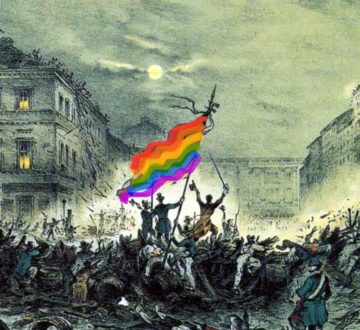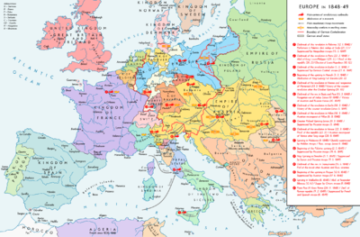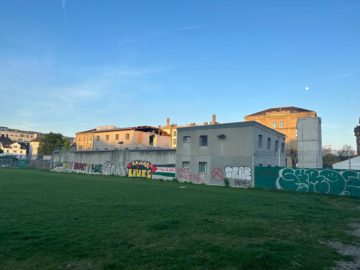by Rafaël Newman

It’s hard to feel sanguine about the human project these days, insofar as there still is, or ever was one. Canada has been on fire, in part evidently because we have yet failed to address the dire effects of our fossil fuel use; while a Ukrainian reservoir, willfully damaged by fascist-imperialist belligerents, is threatening eco-death by flooding, and imperiling the stability of the nuclear reactor it was built to serve. The United States, in the meantime, the country in which we are to place our faith for an end to the latest European violence, is seeing the forces of reaction on the march, waging a proxy war over sexual and reproductive rights (alongside similarly regressive anti-abortion activists in Poland and Italy) to distract from economic inequity, the police murder of Black people, and a brain-eating gun lobby. And all the while, that nation’s principal transatlantic allies—France, Germany, and Britain—have been rendered sclerotic by various strains of autocracy, historical compromise, and nativism.
Nor is a rosier prospect offered by the global south and its various satellites. In Iran, women are beaten to death for sporting the wrong headgear, while in Israel/Palestine a cutting-edge military power is deployed to kill children, there too no doubt in a bid—however vain—to distract attention from government malfeasance, which in Israel’s case constitutes an attempt to refashion the judiciary after ethno-nationalist whim. Female genital mutilation continues to be practiced in Guinea-Bissau, while “gender apartheid” is again the norm in post-occupation Afghanistan. In Turkey, the laicism foundational to the republic’s modern rebirth is being further eroded, by a religious conservative whose hold on power could not be shaken even by his sluggish response to a massive natural disaster (or who perhaps took advantage of that disaster to influence the election results). Over-burdened, under-maintained rail systems bring death and destruction to India (as, of course, to North America). Sudanese civilians are dying in a pointless dispute between military factions. And people trying to reach Europe from Africa, merely to survive, continue to capsize in the Mediterranean—often because they have been repelled by the “forces of order” to face the perils of the open waters in makeshift craft.
If there is any hope for our common endeavor, it comes currently not from our “leaders” but from our streets. Black Lives Matter, Fridays For Future, Jin Jiyan Azadî, Pussy March, Stonewall Was A Riot, Get Your Laws Off My Body, Métro Boulot Tombeau: such are the latest watchwords of a global grass-roots protest movement.
 Today’s demonstrations—in Hong Kong, Milwaukee, Paris, Teheran, Tel Aviv, Toronto—are heirs to a venerable tradition, to which two dates in June attest. This year the month began with the 34th anniversary of Tiananmen Square, where the People’s Liberation Army massacred and wounded thousands of protesting students on June 4, 1989; and this past Saturday it was seventy years since June 17, 1953, the day on which a general strike by workers in the German Democratic Republic was violently put down by the Socialist Unity Party regime, with the vigorous backing of its Soviet patrons. Among the symbolic high points of that latter demonstration, which broke out across the GDR, was the strikers’ attack on the offices of the Volkspolizei, or VoPos, the “People’s Police,” housed in Erich Mendelsohn’s handsome Columbushaus on Potsdamerplatz. And although Katja Hoyer, in a new history of the GDR, points out that the East German police were in 1953 in fact woefully under-equipped, their paramilitary power was to be augmented as a result of the debacle; and thus the assault on their prestigiously located station became, in retrospect, a figurative restaging of the storming of the Bastille, on July 14, 1789, and would eventually lead, just a few years later, to the elegant modernist building’s demolition.
Today’s demonstrations—in Hong Kong, Milwaukee, Paris, Teheran, Tel Aviv, Toronto—are heirs to a venerable tradition, to which two dates in June attest. This year the month began with the 34th anniversary of Tiananmen Square, where the People’s Liberation Army massacred and wounded thousands of protesting students on June 4, 1989; and this past Saturday it was seventy years since June 17, 1953, the day on which a general strike by workers in the German Democratic Republic was violently put down by the Socialist Unity Party regime, with the vigorous backing of its Soviet patrons. Among the symbolic high points of that latter demonstration, which broke out across the GDR, was the strikers’ attack on the offices of the Volkspolizei, or VoPos, the “People’s Police,” housed in Erich Mendelsohn’s handsome Columbushaus on Potsdamerplatz. And although Katja Hoyer, in a new history of the GDR, points out that the East German police were in 1953 in fact woefully under-equipped, their paramilitary power was to be augmented as a result of the debacle; and thus the assault on their prestigiously located station became, in retrospect, a figurative restaging of the storming of the Bastille, on July 14, 1789, and would eventually lead, just a few years later, to the elegant modernist building’s demolition.
 Although both uprisings, the Chinese and the East German, were ultimately unsuccessful, and ended in bloodshed and repression, they live on as symbols of the potential for popular resistance to challenge, or at least shame, authoritarian violence. “June,” a poem by Shi Tao, a Chinese dissident imprisoned following Tiananmen, was taken up by PEN International in 2008 in a “free expression poem relay” as a protest against Chinese human rights abuses in the build-up to the Beijing Olympics (for an English translation, by PEN member Chip Rolley, go here; my own version can be heard on this album). As for June 17, 1953, which has since been immortalized in the name of a street in central Berlin, it was the occasion for a supremely ironic verse by Bertolt Brecht, who was at the time, in the immediate aftermath of Stalin’s death, toeing a very fine line between critique and socialist loyalty:
Although both uprisings, the Chinese and the East German, were ultimately unsuccessful, and ended in bloodshed and repression, they live on as symbols of the potential for popular resistance to challenge, or at least shame, authoritarian violence. “June,” a poem by Shi Tao, a Chinese dissident imprisoned following Tiananmen, was taken up by PEN International in 2008 in a “free expression poem relay” as a protest against Chinese human rights abuses in the build-up to the Beijing Olympics (for an English translation, by PEN member Chip Rolley, go here; my own version can be heard on this album). As for June 17, 1953, which has since been immortalized in the name of a street in central Berlin, it was the occasion for a supremely ironic verse by Bertolt Brecht, who was at the time, in the immediate aftermath of Stalin’s death, toeing a very fine line between critique and socialist loyalty:
After the uprising on June 17
The Secretary of the German Writers’ Guild
Had leaflets distributed in Stalinallee
Which proclaimed that the people
Had lost the confidence of the government
And could only regain it
By working twice as hard. Wouldn’t it
Be simpler though for the government
To dissolve the people and elect
Another one?
The grotesquery of the government of a “republic of workers” firing on those workers was a contradiction too glaring to be ignored, the sort of paradox that would in 1979 lead Benedict Anderson, perplexed at the spectacle of two ostensibly socialist countries in military conflict during the brief Sino-Vietnamese War, to formulate his “imagined communities” theory of the toxic persistence of nationalism.
 Behind and beyond these two iconic moments of popular protest was the revolutionary year 1848, the specter which once haunted old Europe. Known variously as the “Springtime of the Peoples” and as the “Springtime of Nations,” the uprisings began in France in early 1848 and by 1849 had spread to most of Europe. They were preceded, if not sparked, by the publication of the Communist Manifesto in February of 1848, and would eventually see a wide range of results, from reform to retrenchment. What they did certainly give rise to, at least notionally, or in hindsight, was the idea of an international movement: for justice, for freedom, for progress. For democracy. And this despite the various revolutions’ separate calls for the establishment of individual nation-states on the model of the French republic, to replace the ancient régime of hereditary nobility. When strikes broke out among students in Paris and Berlin and Chicago in 1968, among other places, wags suggested that they were merely the farcical replay of the 1848 revolutions—but those strikes were nevertheless in the internationalist spirit of 1848. The Prague Spring, meanwhile, murderously repressed by Warsaw Pact troops in August of 1968 in the name of Socialist brotherhood, provided further evidence of the contradictions inherent in the Soviet Bloc’s claim to the heritage of the Internationale.
Behind and beyond these two iconic moments of popular protest was the revolutionary year 1848, the specter which once haunted old Europe. Known variously as the “Springtime of the Peoples” and as the “Springtime of Nations,” the uprisings began in France in early 1848 and by 1849 had spread to most of Europe. They were preceded, if not sparked, by the publication of the Communist Manifesto in February of 1848, and would eventually see a wide range of results, from reform to retrenchment. What they did certainly give rise to, at least notionally, or in hindsight, was the idea of an international movement: for justice, for freedom, for progress. For democracy. And this despite the various revolutions’ separate calls for the establishment of individual nation-states on the model of the French republic, to replace the ancient régime of hereditary nobility. When strikes broke out among students in Paris and Berlin and Chicago in 1968, among other places, wags suggested that they were merely the farcical replay of the 1848 revolutions—but those strikes were nevertheless in the internationalist spirit of 1848. The Prague Spring, meanwhile, murderously repressed by Warsaw Pact troops in August of 1968 in the name of Socialist brotherhood, provided further evidence of the contradictions inherent in the Soviet Bloc’s claim to the heritage of the Internationale.
Among the practical successes of 1848’s uncoordinated spread—what would today be called a viral phenomenon—was the Bundesverfassung, or Swiss Federal Constitution, whose 175th birthday will be celebrated with a host of events in Bern next month, and in Switzerland up to and including September 12 this year, the actual anniversary of its enactment. The Bundesverfassung, which has since been revised twice, was a typically Swiss compromise, and was the result of a civil war, the Sonderbundskrieg of November 1847, rather than of the sort of popular uprisings seen elsewhere in Europe. But it was a genuinely modernizing document, creating a federal state out of what had been a loose confederacy of largely independent cantons, as well as a bicameral parliamentary system, all of it consciously modeled on the political apparatus developed in the United States, itself still a decade and a half away from its crucial federal test on the battlefields of the American Civil War.
There was a further historic demonstration in Switzerland this past week. On June 14 crowds gathered across the country to stage a Frauenstreik, or “women’s strike,” in commemoration of the first such strike, held in Switzerland on that date in 1991, and revived in 2019. The original demonstration, which began among underpaid female workers in the watchmaking industry in the French-speaking region of Switzerland (for an interview with that strike’s organizer go here), was the country’s largest since the 1918 Landesstreik, or “general strike,” which had itself been violently put down by the military. This year the Frauenstreik has been renamed the Feministischer Streik, or “feminist strike,” to take account of LGBTQIA+ issues and to alert men to the structural disadvantages posed to them as well under the patriarchy. Some 120,000 people assembled and marched in Zurich alone this past Wednesday, calling among other things for the recognition of sexualized violence as grounds for asylum, adequate pay for care workers, and pension equality.
The Feminist Strike in Switzerland goes some way, perhaps, to righting one of the most conspicuous omissions, indeed wrongs, of the 1848 movement—and of course of Switzerland’s wretchedly misogynist record, until the enfranchisement of women in 1971 (and beyond in at least one half-canton): because the denial of political rights to women was among the signal silences of that “modern” 1848 constitution. “Women got absolutely nothing out of 1848,” notes Neal Ascherson, reviewing Christopher Clark’s new history of the revolutionary year throughout Europe.
‘It is difficult to decide what is more striking – the tireless advocacy of the women activists or the immovability of the patriarchal structure they were challenging,’ Clark writes. ‘Women were not enfranchised anywhere in Europe in 1848.’ And yet they fought and died, gun in hand, on the barricades of Paris, Berlin and Milan. In the Frankfurt Parliament, ‘the discussion of votes for women elicited guffaws and hoots from the deputies … and was dismissed out of hand.’ This was to be branded a firmly male revolution, with women celebrated only for waving ribbons from windows at the marching men below.
In Zurich this past June 14, the tables were turned, as women* took over the streets and men* waved from their windows—or joined in the astonishingly peaceful yet noisily resolute demonstration.
As for LGBTQIA+ issues, they were lent further emphasis three days later, by chance on the 70th anniversary of June 17, 1953, when Zurich staged its annual rendition of Pride. Thousands marched through the streets again, and converged in the late afternoon on the Kasernenareal, a former military drill yard and barracks ensemble in the middle of town, for live music and dancing.

There was extra room for the various stages this year, since the prison that had for decades occupied half of the Kasernenareal had been freshly demolished. This does not mean that Zurich is now free of penitentiaries: indeed, the police can do without the holding cells that had stood on that midtown terrain because they have been granted fresh supplementary capacity in a brand-new facility further north in the city. But the razing of the prison on the Kasernenareal, and the celebration on those same grounds of the international event known as Pride, which has its roots in an eminently political protest against the policing of civil and sexual liberty, offers a pleasingly poetic symmetry: on the anniversary of a strike by workers against a cynical regime, which ended in the destruction of a police station, and in an echo of the revolutions that had once reshaped Europe, there was dancing this past Saturday on the ruins of a symbol of repression.
